Egypt was full of charming surprises. Situations that, at first, seemed sketchy and perhaps a little dangerous, kept turning out to be quite the opposite, as you will see.
It started as soon as we entered the Cairo International Airport. Our flight arrived late due to a delayed departure from Morocco and we were definitely not going to make our connecting flight to Luxor, which was scheduled to leave in about ten minutes and we still had to get our visas. Fortunately, we passed an information desk with some harassed-looking attendants -- apparently we were not the only ones with missed connections. However, a young man listened to our story, told us how to get our visas (which was a bit convoluted: pay at one desk then take your receipt to another desk to get the visa), and assured us that he would get us on a later flight to Luxor, hopefully in about an hour. He told us where to wait for him and he would keep us informed. Given the apparent confusion and general uproar of people shouting instructions and making urgent calls, we were not all that hopeful. But, we got our visas, then mustered our patience to wait and see. Contrary to our very low expectations, he returned in about half an hour to let us know that we had two seats on a flight coming from Spain going on to Luxor that evening. He made sure that we had our visas properly pasted into our passports and told us he would be back when the plane landed. We were concerned about our luggage being transferred to the same plane but he assured us that that too would be looked after. Again, we were not too hopeful, but we had emergency supplies with us just in case. A little later, our guardian angel returned and took us to a special security line that was very short and we were rushed through and straight to the waiting plane. Whew! We didn’t have to spend a night in the airport after all!
Luxor
Upon arrival at the Luxor airport, we were surprised and amazed to find that our luggage had indeed arrived with us. We also found our driver, Mohammed (the name turned out to be as popular in Egypt as it had been in Morocco), waiting to take us to our lodging. However, when we saw his vehicle, we again had some misgivings. It looked like a 1965 Peugeot station wagon that had been driven on dusty, pot-holed roads its entire life, which is probably exactly what it was. No seat belts, no a/c, but it got us to our place of rest. However, when we got to our place of rest, we again had some misgivings (are you starting to get the idea?). He drove into a dirt driveway and showed us to our room up an outside stairway. There was a threadbare, or barely there, welcome mat at the bottom of the steps, a rickety banister that wobbled when I grabbed it, and everything felt dusty. Oh dear, what had I gotten us into?

I had purposely booked a place that was “family-run” and sounded local and charming in the reviews. Well, it was late and we would see how things looked in the morning. We were just grateful that the a/c worked and the bed was comfortable and thoroughly protected by a mosquito net.
Over the next few days, despite our initial misgivings, we grew to love our slightly dilapidated guesthouse on the West Bank of the Nile near the entrance to the Valley of the Kings. It was not only family-run, it was a family compound and a village center in many ways that we were gradually allowed to see as they got used to us. Our driver, Mohammed, was part of the family and was available to transport us most of the time. Our hosts also arranged for a local guide to show us the ancient tombs and local sights, yet another Mohammed! With his expert guidance, we made the most of our limited time and learned a great deal. He helped us choose some of the well-known tombs to go into and took us to lesser known sites that were perhaps even more interesting.

Our first morning was spent in the Valley of the Kings.
Mohammed bought us tickets that would give us admission to three different tombs. He also made sure we purchased a seperate ticket that would allow us to take photos inside the tombs. The guides are not allowed to go in the tombs with the tourists, so Mohammed gave us a little history lesson at the entrance to each one and told us some points of interest to look for while inside. Leaving the guides outside contributes to an atmosphere of hushed awe inside, which we appreciated. The three tombs we visited were the Sons of Ramses II, Ramses IV, and Rameses IX. (Ramses was a very common name for pharaohs). I am not going to go into a lot of detail on the history of these ancient Egyptian rulers as you can find it all online. But, I do hope that these photos help to give you a sense of the awe inspiring grandeur and beauty that these people created thousands of years ago -- way before Machu Picchu or the buddhas of Thailand or the headstones on Rapa Nui.
The Sons of Ramses II slideshow (click arrow on the right side of photo to advance)
Ramses IV slideshow (click arrow on right side of photo to advance)
Ramses II slideshow (click arrow on the right side of the photo to advance)
That afternoon, we visited the Valley of the Queens and the magnificent Temple of Queen Hatshepsut. With a backdrop of imposing cliffs behind it, the temple looks out over the plains to the Nile and beyond.

It was built with both architectural precision and astronomical alignment. In the past, it was surrounded by beautiful gardens with exotic plants but now the hills are dry and bare. Still, it has a stark beauty.
We returned to our lodgings in time to relax on our balcony/porch in the late afternoon before dinner.
Dinner was quite the feast -- delicious stewed duck with many trimmings. There was much more than we could eat but we tried hard.

The next morning, the Mohammeds took us to the Deir el-Medina, the site of an ancient village where the artisans who worked on the pharaohs’ tombs lived. It is within walking distance, but not within sight, of the Valley of the Kings.
The foundations of some sixty houses show how the town was laid out.
An interesting fact: This is probably the first place in history where there was a labor strike for better working conditions. In about 1170 BCE, the workers walked off the job to protest lack of food supplies to the village.
Our guide was able to show us the town’s temple and explain the imagery and some of the hieroglyphs.
The overseers of the workmen, who were quite wealthy, hired the best of the artisans to decorate their own modest tombs that were dug into the hills above the town. Unfortunately, we were not able to take photos inside these well preserved tombs. They depicted many detailed scenes of everyday life at the time, which we found to be more interesting, if less grand, than the tombs of the royalty that repeatedly depicted the Egyptian gods and scenes from their mythology. If you go to Luxor, we definitely recommend a trip to this site. Not only was it fascinating, we had it all to ourselves.
That afternoon, Mohammed (our guide), had arranged to take us on a boat ride up the Nile to Banana Island. We had no idea what to expect but, when it was offered to us, it sounded like a refreshing change from the dry, sandy hills and hot, stuffy tombs. We boarded a colorful little sailboat but there wasn’t enough wind to push us against the current, so our captain hitched a ride from a motorized ferry boat with a long tow rope. Soon another sailboat hitched on, then another, and another. Eventually, we had a ‘train’ of five sailboats being towed up the river. It seemed to be a common occurrence as all the boatmen were quite adept at the procedure.

On the “island”, which is probably not an island, we walked through a banana plantation and Mohammed peeled back the petals of the alien looking purple banana flower to show us the baby bananas developing in layers underneath.

Goats roamed among the banana trees.

We also saw an interesting old water wheel that must have been used for irrigation at one time.
That was the extent of the interesting part of the visit. The rest was rather sad. There was a sort of “zoo” with monkeys, some birds, and two crocodiles in small, filthy enclosures. It was too depressing to even take pictures. I have since learned that there used to be a lovely, eccentric place called Banana Island on the east bank that was a great place to visit but somehow, this place took over the name. Don’t bother visiting.

We had some refreshing fruit in the cafe that helped get rid of the bitter taste of seeing those poor animals before returning to our guesthouse.
That night, we tried the duck dinner again to make sure it was as good as we remembered.
In the morning, Mohammed (our driver), took us across the river to the main city of Luxor to visit an ATM and find a pharmacy. What a dusty, busy, chaotic place. We were glad to return to our slightly dilapidated, peaceful, friendly guesthouse on the west bank.
It was still early, so we decided to walk down the street to take a look at the Colossi of Memnon and Amenhotep III Temple Conservation Project.

To get there, we first walked through an area that appeared to be a mud brick factory, probably to create bricks for the restoration using the traditional methods.
The project itself was surrounded by a protective wall that was low enough we could still get a view of the site over top of it. We got some pictures from a distance, but then a guard came over and offered to take some close ups for us. Of course, he expected a good tip for his services.
When the restoration is complete, this will be a spectacular site and I hope that we can return some day to see it. You can learn more about it from this report written by the head conservators on the project.
At this point, there was quite a sandstorm blowing up so we decided to return to our lodgings. These sandstorms blow frequently and are why everything always feels dusty here all the time.

Returning to the guest house, we noticed clay discs with bread dough rising on them.
Of course, we expressed interest and the elderly gentleman we had been greeting whenever we passed him as he sat in the garden, offered to show us where the bread was baked. He took us down a short path to where a woman was tending some loaves in a beehive type of oven. The inside was large and could hold many loaves at once. Given the size and location, we assumed that it was a community oven similar to what we had seen in Morocco. Notice the little pocket for matches to the right of the opening and the holes near the top that can be plugged with rocks or opened for ventilation.


This is the fresh bread we had with every meal that came from that oven.
After we got a good whiff of the bread baking in the oven, the elderly gentleman pointed around the corner to show us where a group of children were seated on the floor of a large room being instructed by a teacher -- the village school. However, we didn’t take photos as it seemed inappropriate. We had also noticed on several occasions that a number of men gathered to perform their prayers in the garden of the guesthouse and that the elderly gentleman seemed to be their leader. This is when we realized that the place we were staying served as a village center in many ways. Our guest house was called Nour el Gourna: nour meaning light or illumination and Gourna being the name of the village.

Just across the road from our guest house there were a number of abandoned houses on the hill behind a retaining wall. We learned that they used to be part of the village of Gourna (or Qurna or Kurna or several other spellings) but the residents were relocated to new housing to prevent them looting the tombs buried in the hill beneath them and to allow for future excavation of the tombs.
That evening, we couldn’t resist one more duck feast -- it was that good.

In the morning we said goodbye to the shaded garden of Nour el Gourna and headed off for six days on the Nile. Look closely and you will see someone in the doorway waving goodbye to us.
We were picked up in a van and driven to Esna, about 30 miles from Luxor where we would board our dahabiya for our trip up the Nile to Aswan.
Traveling Up the Nile
Confession time: Another mystery series is responsible for this part of the trip. (If you have read the other blog posts, you’ll know about some of the other books that played a part in our trip planning.) This time, it was the Elizabeth Peters series about Amelia Peabody and Radcliffe Emerson, fictional Egyptologists who excavate tombs and solve mysteries in the desert in the early part of the 20th century. I particularly loved the description of traveling up the Nile on a dahabiya, a traditional riverboat with sails. It sounded so romantic and exotic.

Here is an old photo of a dahabiya.
There are dozens of motorized cruise ships that will take you from Luxor to Aswan on the Nile but only one outfit that I found that actually uses dahabiyas -- Nour el Nil. They reintroduced the dahabiya to the river by building new ones. We traveled in a convoy of four boats. Our boat was their first and smallest of the fleet and carried sixteen passengers.
We were taken on board and shown to our cozy cabin with an ensuite bathroom. There was a refreshing fruit drink waiting for us.
There was a spacious upper deck where we could hang out and watch the scenery and where we would eat our meals family style.


However, before setting sail, we were taken for a walk through town to visit the Temple of Khnum, the ram-headed creator god who fashioned humankind on his potter’s wheel. It was built about a century BCE, then abandoned during the Roman period, gradually covered by the desert sand and debris and eventually by the town of Esna. It is now almost thirty feet below street level so we approached it from above.
Inside, restoration work was ongoing but we were able to get a good look at some massive columns covered in hieroglyphs.
Through a screened window at the back of the temple we could watch a crew of men excavating and passing sacks of dirt up the hill by hand like a fire brigade.
Back on the dahabiya, we watched as the boat was towed away from shore and we began the journey to Aswan. As we got out into the wind, the dahabiyas started to unfurl their sails.
In the afternoon, we stopped and took a walk around an agricultural area with green fields and an interesting irrigation system.
Eventually, we walked through a little cluster of houses and were welcomed into the courtyard of one of the homes where we saw another large outdoor oven and played with ducklings. The family had a little reception ready for us with refreshments and proudly let us peek into their house, which was apparently built by an archeologist years before -- it was quite European in style.
That evening, we had the first of many delicious meals on board as we got to know our shipmates.

While we ate breakfast the next morning, the crew moved the boat upriver to a new location and we again disembarked for a walk, this time to see the temple of Nekhbet, the white vulture goddess and protector of upper Egypt. To get there, we walked past a massive mud brick wall, built in the 4th century BC, that is thought to have protected the city of El Kab, once the capital of Upper Egypt, from destruction by the floodwaters of the Nile. Amazing that so much of the wall is still intact.
Across the modern railway tracks and the highway to Cairo, in the hills above the ancient town, is the necropolis of Nekhbet.
Here we met Ahmed, an Egyptian scholar who would be our guide for several days as we explored the historical sites along the Nile. He interpreted the images and symbols for us in a very understandable manner.
Looking back from the necropolis, we could see the protective wall extending in both directions and the river beyond.

Back on board, we enjoyed a delicious lunch as the boat sailed on. In the afternoon, Ahmed met us again at Edfu, waving to us from shore as the boat docked. Here we were going to visit a Greco-Roman temple dedicated to the god Horus.

Ahmed and the crew organized all of us from the four boats into horse-drawn carriages for a ride through the city to the temple. With more than thirty carriages milling around, you can imagine it was a bit confusing. But, they were obviously experienced at sorting out such chaos and soon had us loaded and on our way.
It was a charming way to see the town on the way.
Even after all the tombs and temples we had seen, this one was truly impressive. The walls are massive and the images are well preserved,
Ahmed told us stories about how the priests used rituals (and sometimes tricks) to impress the common folk and extract food and gifts from them, which were intended for the gods, of course.
In the courtyard, before the front gates, the people would gather for ceremonial occasions. The massive gates are 36 m, or almost 100 ft tall. The giant slots in the walls on either side held flags on tall standards. Inside the walls are stairs and small rooms with slots looking out over the courtyard. It was easy to imagine the impression that such grandeur and pomp would have on the crowd.
Trot, trot, trot back to the boat and move on down the river.
The next day, the wind had died so the sails did us no good and we were towed by a tug boat. There were no temples or ruins this day so we watched the scenery drift by.
In the afternoon, we stopped at a grassy bank where we could get out for a short walk.
There was also a flock of rather tame ducks that one of the crew went out to feed.

Mysteriously, we had duck for dinner that night below the floodlit temple of Gibel Silsileh.

After dinner, as we were all getting drowsy and thinking about bed, we heard drumming and tambourines coming up from below. The crew arrived with jingling scarves for us to don and got everyone up shaking our hips to the delightful music. I am not sure why the video starts out sideways but it does straighten out.
After that excitement and a good sleep, we again met Ahmed in the morning to explore the shrines and quarries on the bank. Gebel Silsileh is at the point where the Nile is at its narrowest and the sandstone cliffs crowd it on either bank. Here are the sandstone quarries where ancient workmen carved out huge blocks for many of the major tombs and loaded them on barges for transportation up or down the river. Ahmed showed us how they would make cavities in the rock and insert wooden pegs, which would then be soaked with water. When the water froze in the cold nights, the wood would expand and split the rock. Hard to imagine the persistence it must have taken. The quarry itself was like a shrine to the ingenuity and hard work of those long ago laborers with the raw beauty of the hewn rock glowing in the desert sun.
There was a small shrine at the site, which we were able to enter through a narrow fissure created by a past earthquake that split the wall in the middle of a seated statue.

Across the river we could see the remains of other quarries.

A little way down the river, we stopped again and were taken to a colorful cafe for a tea/coffee break. Groups of local men (no women) were chatting and some were playing dominos.
One of our shipmates joined the dominos game with the help of a couple of our crew.
While we were gone, the kitchen crew had prepared a special lunch of Egyptian specialties that they served in the traditional manner, seated on cushions on the floor.

After lunch, some folks jumped in for a swim. Not us. Although things looked green and clean here, we did not trust what might be getting washed downstream. A little later, the crew from all four boats set up nets for a competitive game of “futbol” while we cheered from the deck of the boat. Two of our shipmates joined the game.
That evening, we were treated to a lovely sunset as we sailed on up the Nile to Kom Ombo, an agricultural city of about 60,000 people.

In the morning, Ahmed met us at the Temple of Kom Ombo which dates from about 100 BCE. This temple is constructed in an unusual double design with symmetrical courts, halls, and sanctuaries in each half.
One side of the temple was dedicated to Sobek, the crocodile god of fertility and creator of the world; while the other side is dedicated to Horus the Elder, the falcon god. You can see the images of Sobek in these photos.

There were many mummified crocodiles found when they excavated this temple, some of which are in a nearby crocodile museum. We weren’t allowed to take photos inside the museum but here is one of the crocodile coffins that were lined up outside.

At this site, we were able to look down into the Nileometer, which was used to measure the rise and fall of the river level as it flooded the valley each year and then retreated, and thus to predict seasonal harvests (and taxes).

There was also a rare architectural artifact here that interested David -- a wall where several wooden pegs that were used to "tie" the stone blocks together had survived the ages. Elsewhere, we had seen the carved slots but the wood had long since rotted away.
This is the last time we would see Ahmed, so he wanted to take some group photos. Some of our group is absent because they went with a French speaking guide on the tour of the temple.
The next day, we would be disembarking in Aswan. When we docked near Aswan that evening, we could see the city lights reflected in the river on the other bank.

Aswan
Since we were disembarking in the morning and couldn’t check into our Aswan lodgings until later in the afternoon, we had taken advantage of our boat captain’s offer to arrange a tour of the local sites with a knowledgeable guide. We shared the tour with Nancy and Bill, a couple from Alaska we had gotten to know on the Nile. It was a bit of a whirlwind around town including a drive to see the unfinished obelisk and then the high dam, a boat ride to the Philae Temple, another boat ride to the Satet Temple on Elephantine Island, and yet another boat ride to see the botanical gardens on El Nabatat Island.
The unfinished obelisk is partially cut out of the rock at a quarry looking over the city. Work was abandoned because cracks appeared before completion. It would have been the tallest obelisk ever erected in ancient Egypt by far and it would have weighed about the same as 200 elephants. An ambitious project!

The drive to the Aswan high dam took us a little further up the river where we could walk along the top looking out to Lake Nasser behind it and the enormous hydro-electric plant on the other side.

We had to go through a police checkpoint at the entrance and there were armed guards in evidence along the walkway. Information panels told the story of the long and arduous construction and its role in industrializing Egypt. The full history of the dam is a fascinating study in international relations with Egypt negotiating with the both U.S. and the USSR for funding. In the end, the USSR provided the needed support and there is a giant monument to Arab-Soviet friendship at the site.
We had to go through another security gate at the entrance to the Philae Temple, which is on an island between the old Aswan low dam, constructed in 1902, and the newer high dam, constructed more than half a century later. The temple was moved to its current location as part of a UNESCO salvaging project to rescue monuments that would have been inundated by the creation of Lake Nasser upon completion of the high dam in 1970.
Back on the boat to Elephantine Island.
The Temple of Satet on Elephantine Island was originally a small sanctuary founded about 3000 BCE. It was gradually expanded and rebuilt several times over the next 3000 years, so parts of it are really, really old. An armed guard accompanied us as we walked around the site. We weren't sure if he was there to protect us or to shoot us if we tried to grab a rock.
There was also a small museum displaying some of the relics found there.
On the boat ride to the Botanical Garden, we passed some colorful houses on the shore.

By the time we got to the Botanical Garden, we were tired and all I wanted to do was sit in the shade. The boat dropped us at the entrance on the south end of the island and there was a long walk to the exit at the other end of the island where there was a small cafe. We found a few benches along the way for short rests, but mostly we just wanted to get to the cafe for a refreshing drink. However, if you lived in the dusty, hot, noisy city, this would be a lovely retreat for a day trip.

After our day of touristing, we looked forward to settling into our guesthouse, which, it turned out, was back on Elephantine Island near the Temple of Satet we had visited. Earlier in the day, our guide had contacted our lodging to arrange transportation back to the island. A young man picked us up in a small motorboat at a dock in the city and helped us with our luggage. He took us back toward Elephantine Island, but this time we rounded the northern tip where the temple and museum are to get to the west side.
He pulled us into a grassy bank on the other side of the island and led us up a trashy looking bank with rough steps to a rather bleak looking area at the top. Once again, I thought to myself, “What have I gotten us into this time?”
However, this actually turned out to be one of the most charming surprises yet. Our guest house turned out to be the colorful house I had photographed on the way to the Botanical Garden earlier.
We were greeted by our host, Mr. Mohamed, a distinguished gentleman who made us mint tea and offered to arrange dinner to be delivered to us and assured us of his assistance with anything else we needed.
Dinner arrived on the head of a little lady clad all in black with a special donut on her head for carrying the large tray and its colorful lid. We had soup, grilled chicken, vegetable curry, rice, pita and tahini dip. Simple but delicious!
Our place was spacious with two bedrooms, one for sleeping and the other for hanging our laundry to dry. We also had a full kitchen where we could make our own coffee or tea, and a cat that came for visits.
The view from our window towards the western river bank was absolutely serene, especially in the early morning before any boat traffic disturbed the perfect reflections.
To add to the rural scene, a herd of goats passed by each morning.


Breakfast was delivered on the head of our little lady in black each morning. Fresh, homemade falafels with tahini dip, boiled eggs, and warm pitas with cheese and jam.

On day two in Aswan, we had arranged for our young boatman, Abdul, to take us back over to the city. He picked us up in his boat, the Free Bird.
David wanted to get a bottle of scotch, which isn’t that easy to do in a muslim country. Abdul said he would drop us at the KFC dock. We didn't think anything of the name until we saw the familiar colonel on the side of the building. At least it wasn't a Starbucks.

Our guide from the day before had pointed out a certain area where he said there was a store that sold alcohol but we walked up and down several blocks with no luck.
Eventually, these two characters asked if we needed assistance and took us to a restaurant/bar at the water’s edge where a woman sold us a bottle from the bar stock.

Then, they coaxed us into taking a ride in their carriage around the markets. “How much?” we asked. “For free,” they said, “no cost.” Fat chance, I thought. However, we had a half hour before being picked up at the dock, so we went along for the ride. It was pleasant, clip clopping along, but after the colorful markets of Morocco, things looked pretty dingy. We did pass some interesting street art on the walls.
Of course, once we alighted from the carriage at the dock, they started to wheedle money out of us “to pay for clothes for all our children”. We bantered back and forth a bit but in the end, we gave them something. Their families do, indeed, need tourist dollars to survive, and from the looks of it, tourism was not booming at the moment.
On our way back to our island retreat, Abdul offered to take us for a tour on the river the next day and show us some of his favorite childhood places. We jumped at the chance.

That evening, dinner was fresh Nile perch charred over an open fire. The crispy skin and the tender flesh were perfect.
And the sunset glowed behind the dome on the hill for us that night while we sipped our nightcap of cheap scotch.

In the morning, Abdul first took us close to the opposite bank so we could see openings in an old wall at the top of what appeared to be long stairways, now mostly covered by sand, leading up from the river. At the top of the hill is the domed structure we could see from our windows. This area is the site of the ancient Tombs of the Nobles where there is ongoing excavation. We did not make the hike up the hill, but there are some tombs there available for viewing.

My favorite part of the day was when Abdul took us through some narrow channels among small, rocky islands inhabited only by birds. For a while, he turned off the engine and we glided silently along listening to their occasional chirps and whistles. This was his childhood retreat.
Coming out of the islands, we came across this sight -- someone hidden by the reeds they were harvesting.

From our guest house windows, we sometimes heard loud music coming from the little ferry boats going back and forth on the river. Sometimes they would stop for a while and we could hear laughter and loud talking along with the music. We came to call them party boats. Here we got a close up as one passed us on the river and we took a short video of people dancing to the music.

Abdul informed us that they are mostly young people from Cairo who come to the beaches of Aswan to party. Further on, we did see people enjoying a sandy beach and splashing in the water.

The beach is near an area of colorful hotels along the bank called the Nubian Village. However, it looked like a “village” just for tourists.

We later learned that our guesthouse was on the edge of a genuine Nubian village with winding narrow passages between the houses that we navigated a few times getting from our side of the island to a ferry dock on the other side where Mr. Mohamed and Abdul had small shops. We visited Abdul at his tea and spice shop and he was so proud and hospitable, sitting us down for mint tea, and finding me some balm for my sore knee. He rented his space from Mr. Mohamed, who seemed to be a village elder and father figure.
Here is the labyrinthine route we had to take through the village back to our guesthouse.
Fortunately, despite all the twists and turns, all the passageways lead in the same general direction. However, I digress -- back to our day with Abdul.
After we finished our river tour, we were interested in getting some lunch and Abdul offered to take us into the souk in Aswan for “real Egyptian food.” Of course, we couldn’t resist that. After a short walk through a crowded street, we entered an unremarkable door that did not look promising, but the inside was cool and elegant. No one but a local would have known it was there (another charming surprise).
Abdul ordered the food and we shared a delicious feast with him and talked about his life in Aswan. He said that this restaurant was where his family used to come for special occasions. After we finished, Abdul excused himself and we thought he was going to use the restroom, but we discovered he paid for the meal. I admonished him but he insisted that we were his guests. He was so sweet, I wanted to adopt him and bring him home. You can bet we gave him an extremely generous tip for the day’s tour to offset the cost of the meal.
On our way back to the boat, David decided to make a detour to the restaurant/bar for a second bottle of scotch to take with us when we left Aswan as it was so hard to find the stuff. As Abdul and I waited on the boat, I was watching the activity on the dock and I caught him watching me with a curious look on his face, and he said, “I am so proud. So proud that you stayed with us.” I took him to mean, staying on the island in the Nubian village as opposed to staying in a fancy hotel in the city. I assured him that we absolutely loved our stay and appreciated their hospitality.

I have since learned that Aswan used to be at the border between ancient Egypt and the Nubian kingdom. The Nubians are an indigenous people, many of whom were displaced by the building of the high dam and the subsequent flooding of the valley above the dam. There is currently a movement by Nubians in Egypt to obtain recognition as a minority population with constitutional rights. There were other guest houses being built next to the one we were staying in and I now think that they are part of an effort (by Mr. Mohamed and Abdul???) to bring tourist dollars and some economic prosperity (and perhaps cultural pride) to the little Nubian community on Elephantine Island. Abdul’s pride made me extremely happy that we had taken a chance on staying in their little guest house called Meshra Katto, which Abdul said means “our home” in their language.
The next morning, Abdul took us to the train station for our trip back to Luxor. There we would be picked up for a tour through the western desert with a Bedouin guide. It was sad to say goodbye to Abdul. Here I am on the train, keeping out the morning draft with the rug he had picked up for me in the market the night before. It was the same fabric as a cushion I had admired on the street near the restaurant he had taken us to.












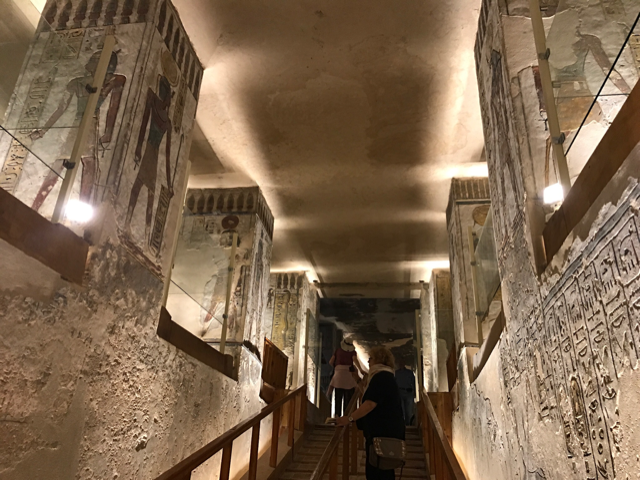





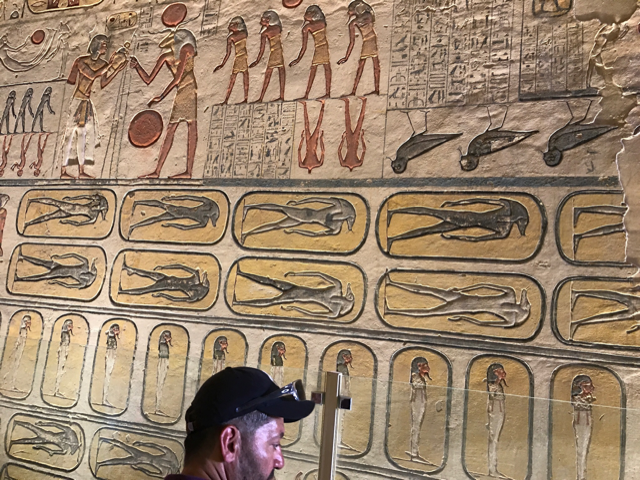

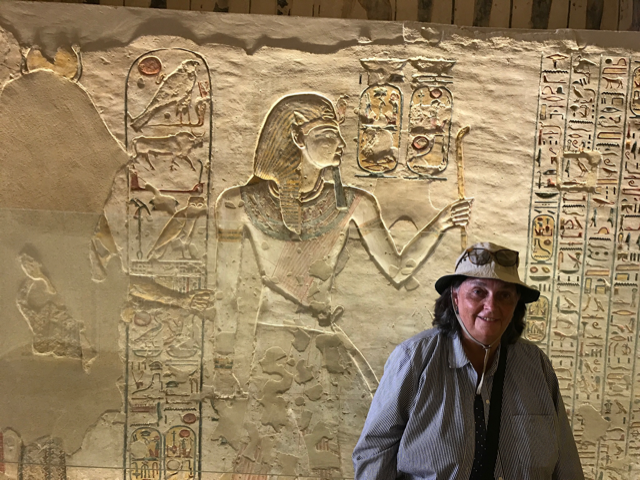

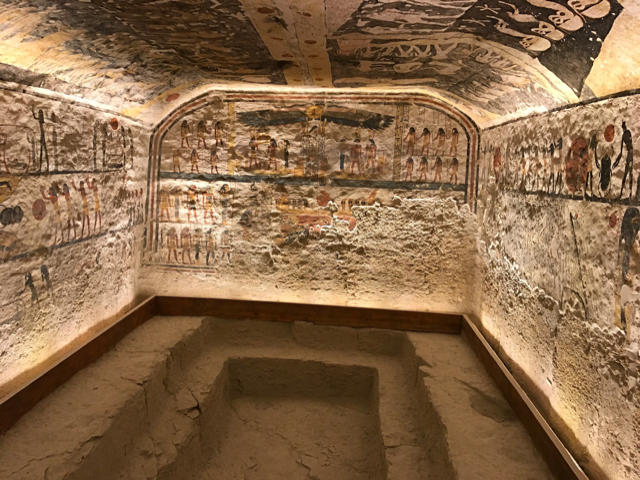

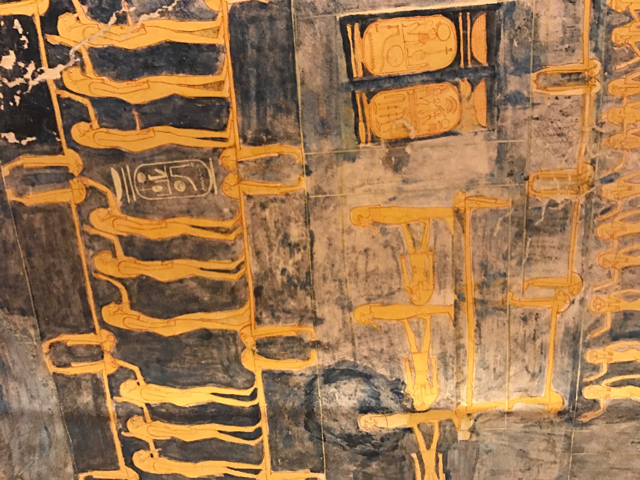



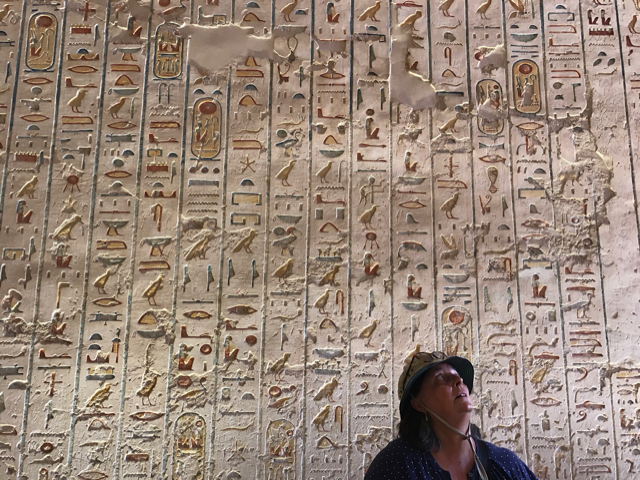

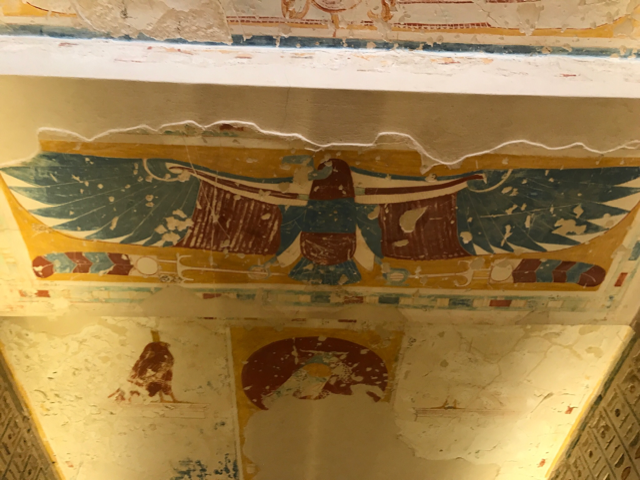



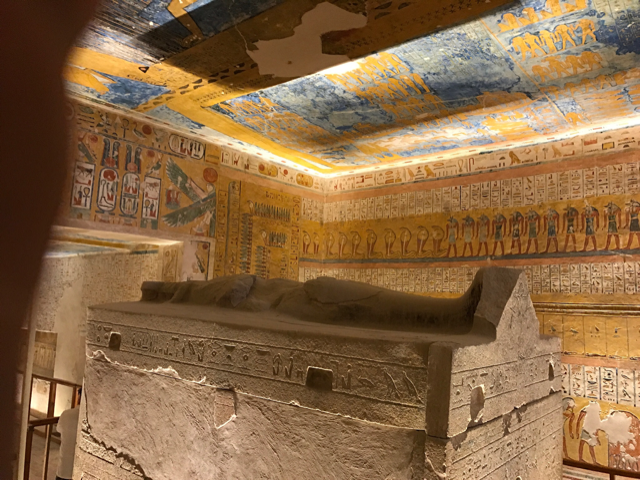

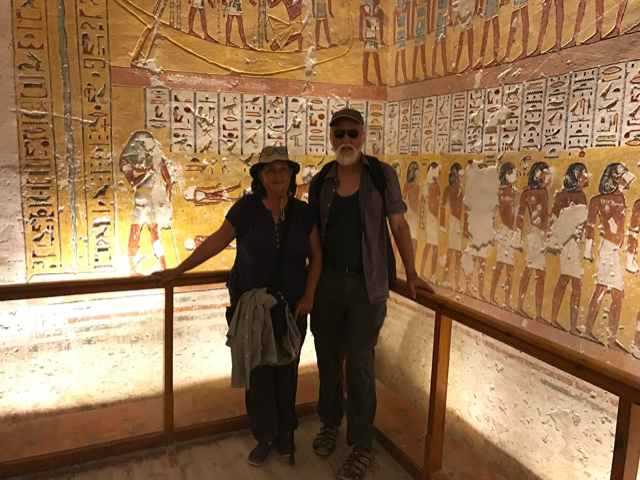


















































































































































































































































































Comentários